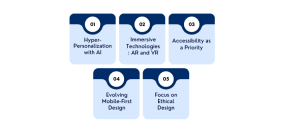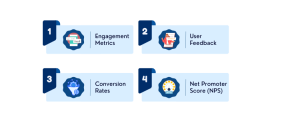to us to know how to promote business on the World Wide Web. We tell
them about different strategies that they can use different stages of their growth.
ContactUs
- +91-810-362-8856
- 106, Silver Arc Plaza, Janjeerwala Square, Indore – 452001, MP, India
-
Mon-Fri: 9am-8pm
Sat: 10am-6pm
Sun: Closed
Follow Us
How to Optimize Your Website for User Experience (UX) in 2025
Why UX Matters More Than Ever
User experience (UX) is the heart of modern web design. Entering 2025, creating seamless and engaging experiences is crucial for attracting user attention and boosting conversions. Whether you run an e-commerce platform, a blog, or a service-based website, exceptional UX ensures higher satisfaction, loyalty, and business success. Let’s explore the strategies and trends shaping UX in 2025 and how you can leverage them to create a user-friendly website.
Emerging UX Trends to Watch in 2025

1. Hyper-Personalization with AI
Artificial intelligence is redefining personalization. From dynamic content to tailored product recommendations, AI enables websites to deliver experiences that feel custom-made for each user. Advanced algorithms analyze user behavior, enabling hyper-specific adjustments that resonate on a personal level.
Related- The Power of Personalization: How to Tailor Your Digital Marketing Strategy in 2024
2. Immersive Technologies: AR and VR
Augmented and virtual reality are transforming how users interact with websites. Imagine virtual tours, 3D product showcases, or immersive storytelling that captivates your audience. Retailers, for example, can allow customers to virtually try on products, boosting engagement and confidence in purchases.
3. Accessibility as a Priority
Inclusive design is no longer optional. Ensure your website is accessible to everyone by integrating screen reader compatibility, clear navigation, and features for users with disabilities. Compliance with Web Content Accessibility Guidelines (WCAG) isn’t just ethical; it’s essential for reaching a broader audience.
4. Evolving Mobile-First Design
Mobile usage dominates the digital landscape. Websites must be responsive, fast, and optimized for touch interfaces, including foldable devices and advanced screen formats. A mobile-first approach ensures consistency and usability across all devices.
5. Focus on Ethical Design
With users becoming increasingly conscious of their digital footprints, ethical design practices that prioritize transparency, data security, and non-invasive interfaces are gaining traction.
Key Principles of Exceptional UX Design
1. Simplicity and Intuition
Keep your website’s design clean and straightforward. Users should intuitively know how to navigate and find what they’re looking for without encountering friction.
2. Consistency Builds Trust
A cohesive design—consistent fonts, colors, and layouts—reinforces brand identity and makes users feel at ease. Familiarity is key to fostering long-term user engagement.
3. Interactive Feedback
Micro-interactions, such as button animations or progress indicators, keep users informed and engaged throughout their journey. For example, a subtle hover effect can make the website feel more dynamic and responsive.
4. Performance Optimization
Fast-loading websites are essential. Optimize images, use caching, and minimize unnecessary scripts to enhance speed. Google’s Core Web Vitals can help measure your site’s performance effectively.
5. Clarity in Content Presentation
Readable fonts, ample white space, and well-structured layouts improve content comprehension. Break long paragraphs into digestible chunks to make your content accessible to all readers.
Steps to Elevate Your Website’s UX
Step 1: Deep Dive into User Research
Understanding your audience is the first step in crafting an effective UX. Analyze user data to uncover behaviors, preferences, and pain points. Conduct interviews, surveys, and usability tests to gather qualitative insights. Tools like Google Analytics and heatmaps can offer actionable data about user behavior.
Step 2: Simplify Navigation
Ensure that your website structure is logical and intuitive. Incorporate breadcrumb trails, intuitive menus, and prominently placed search functionality.Consider implementing mega menus for websites with extensive content to prevent users from feeling overwhelmed.
Step 3: Prioritize Visual Appeal
Adopt modern design trends such as minimalism, high-contrast colors, and innovative layouts like neumorphism or glassmorphism. Use visuals strategically to complement your content and avoid cluttering the screen.
Step 4: Embrace Mobile Optimization
Test your website’s responsiveness across devices. Prioritize mobile-friendly designs and explore voice search optimization for better usability. Mobile users should experience the same functionality and performance as desktop users.
Step 5: Incorporate Accessibility Features
Design with inclusivity in mind. Add alternative text for images, subtitles for videos, and keyboard navigation to create a welcoming experience for all users. Additionally, design for color blindness by avoiding reliance solely on color to convey meaning.
Step 6: Improve Content Loading Speed
Slow websites deter users. Compress images, enable lazy loading, and leverage Content Delivery Networks (CDNs) to ensure your website loads quickly and efficiently. Aim for a loading time of under 3 seconds.
Tools and Resources for UX Excellence
1. Heatmap Tools
Tools such as Hotjar and Crazy Egg allow you to visualize user interactions, providing insights into areas that need improvement. Heatmaps reveal where users are clicking, scrolling, and spending time on your site.
2. Performance Tools
Use tools like Lighthouse and GTmetrix to enhance website speed and performance. These tools provide actionable recommendations to improve your website’s Core Web Vitals.
3. Accessibility Checkers
Evaluate inclusivity with tools like Axe or WAVE. These tools help identify areas where your site can improve accessibility and ensure compliance with WCAG standards.
4. UX Design Software
Platforms like Adobe XD, Figma, and Sketch allow you to prototype and design user-friendly interfaces efficiently. Testing prototypes before implementation reduces design errors.
Measuring UX Success: Key Metrics

1. Engagement Metrics
Track metrics like bounce rates, session durations, and pages per session to gauge user interaction. Low bounce rates and long session durations indicate a positive user experience.
2. Conversion Rates
Monitor how effectively your website turns visitors into customers or subscribers. High conversion rates often correlate with excellent UX.
3. User Feedback
Collect qualitative insights through surveys, feedback forms, and user testing. Listening to your audience provides a roadmap for continuous improvement.
4. Net Promoter Score (NPS)
Measure user satisfaction and loyalty using the NPS metric. It’s a simple yet powerful way to gauge how likely users are to recommend your website to others.
Iterative Approach to UX Optimization
UX optimization is an ongoing process. Regularly review analytics, test new features, and adapt to emerging trends to ensure your website remains user-friendly. Conduct periodic usability testing to identify and fix any pain points.
Conclusion: Stay Ahead with Exceptional UX
Optimizing your website for user experience is an ongoing journey. By staying updated on trends, focusing on personalization, and prioritizing inclusivity, you can create a website that not only meets but exceeds user expectations. Remember, a website’s design is more than just aesthetics; it’s about delivering value and fostering connections. Invest in UX today to thrive in the competitive digital landscape of 2025.
